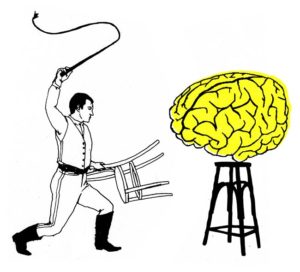Rumination and self-reflection – Is your thinking over the limit ?
May 19, 2018 | Uncategorized | 1 Comment
Like many things in life, food, and sleep for example, thinking is another aspect where things that are inherently good for health and well being, can sometimes be a bad thing when used excessively. In this post I want to explore an example of this. Self-reflection and rumination.
What is rumination and self-reflection
 Self-reflection is the action of thinking about your own feelings and behavior, and the reasons that may lie behind them. Rumination is repeatedly and passively thinking about the causes or consequences of problems without moving to active problem solving. Both are examples of adaptive behaviors so it is not a question of whether they are good or bad, but whether they are useful or not. Self-reflection is associated with the ability to exercise more control over one’s feelings and behavior and generally to make better decisions in terms of how to respond. It is associated with the ability to learn and change. Conversely, rumination is a key contributor to mental health disorders such as depression and anxiety.
Self-reflection is the action of thinking about your own feelings and behavior, and the reasons that may lie behind them. Rumination is repeatedly and passively thinking about the causes or consequences of problems without moving to active problem solving. Both are examples of adaptive behaviors so it is not a question of whether they are good or bad, but whether they are useful or not. Self-reflection is associated with the ability to exercise more control over one’s feelings and behavior and generally to make better decisions in terms of how to respond. It is associated with the ability to learn and change. Conversely, rumination is a key contributor to mental health disorders such as depression and anxiety.
How do I tell the difference?
So at this point a good question might be how do I know whether I am ruminating or self-reflecting, and if I’m ruminating how do I move back to self-reflection or at least stop ruminating.
Differentiating between self-reflection and rumination can sometimes be done through the perspective of negative or positive content of the thoughts. Rumination will generally have exclusively negative content whereas self-reflection will either have a mixture of negative and positive or just positive content. There are also process differences as rumination will not result in a move to a problem-solving mode whereas reflection will. Finally rumination will tend to persist for a longer period of time than self-reflection.
An example of the differences. Self-reflecting on a presentation I need to give tomorrow, considers my past experiences, good or bad, and then realistically identifies my strengths and weaknesses and taking action to address deficits is a self-reflective process. A ruminative approach would be to reflect on past experiences, focussed on bad experiences and based on a likely negative outcome, and then project further consequences of that.
What can i do if I find myself ruminating?
Indicators of rumination could be body sensation; headaches, pains or tightness similar to stress, difficultly in sleeping, loss of appetite. It could be mental symptoms such as loss of concentration and focus or just an inability to stop thinking. The key to stopping ruminating is firstly noticing these symptoms. The next step is to do something different to break this cycle. This could be meditation, physical exercise, mental distractions such as thinking of other things, talk to a close friends or family member (beware of those who tend to have their own issues with ruminating). If all else fails mindful breathing is a great thing to do in the moment as a combination of deep breathing and noticing your body will tend to immediately break the cycle so you can put in place other more productive cognitive strategies such as reappraisal, reviewing the evidence in terms of likely outcomes and likely consequences of these outcomes, and problem solving.
In conclusion…..
I encourage you to self-reflect, as this is a very healthy pursuit, and to become aware of when you are over your thinking limit. Notice the physical and mental symptoms of rumination and take action to stop the rumination cycle.



 What is a strength
What is a strength Failure is the state or condition of not meeting a desirable or intended objective. It can also by considered as the opposite of success. From a psychological perspective there is as construct called Fear of Failure and it is considered an avoidance orientated achievement motive. In non-psychology terms this means it creates a reason to avoid embarking on activities which would lead to the achievement of goals.
Failure is the state or condition of not meeting a desirable or intended objective. It can also by considered as the opposite of success. From a psychological perspective there is as construct called Fear of Failure and it is considered an avoidance orientated achievement motive. In non-psychology terms this means it creates a reason to avoid embarking on activities which would lead to the achievement of goals. Cognitive psychology is a field of psychology that is still maturing. It attempts to take a more systems based approach to the processes of the mind. Having come from an Information Technology background I have a strong preference for this approach. Unfortunately, the accuracy of any theory is fraught with error, as unlike with computer hardware which is designed by a human being, the brain was not. Therefore a lot of assumptions tend to be made about the inner workings of the brain. Whilst cognitive psychology is a science, theories are still prone to changing.
Cognitive psychology is a field of psychology that is still maturing. It attempts to take a more systems based approach to the processes of the mind. Having come from an Information Technology background I have a strong preference for this approach. Unfortunately, the accuracy of any theory is fraught with error, as unlike with computer hardware which is designed by a human being, the brain was not. Therefore a lot of assumptions tend to be made about the inner workings of the brain. Whilst cognitive psychology is a science, theories are still prone to changing. No this isn’t a misquote. Understanding and responding to your desire to procrastinate can result in your being able to spend less time on procrastinating and more time on the task you have been avoiding. Like
No this isn’t a misquote. Understanding and responding to your desire to procrastinate can result in your being able to spend less time on procrastinating and more time on the task you have been avoiding. Like 

